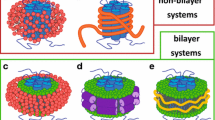Abstract
Membrane proteins classically are handled in aqueous solutions as complexes with detergents. The dissociating character of detergents, combined with the need to maintain an excess of them, frequently results in more or less rapid inactivation of the protein under study. Over the past few years, we have endeavored to develop a novel family of surfactants, dubbed amphipols (APs). APs are amphiphilic polymers that bind to the transmembrane surface of the protein in a noncovalent but, in the absence of a competing surfactant, quasi-irreversible manner. Membrane proteins complexed by APs are in their native state, stable, and they remain water-soluble in the absence of detergent or free APs. An update is presented of the current knowledge about these compounds and their demonstrated or putative uses in membrane biology.
Similar content being viewed by others
Author information
Authors and Affiliations
Corresponding author
Rights and permissions
About this article
Cite this article
Popot, JL., Berry, E., Charvolin, D. et al. Amphipols: polymeric surfactants for membrane biology research. CMLS, Cell. Mol. Life Sci. 60, 1559–1574 (2003). https://doi.org/10.1007/s00018-003-3169-6
Issue Date:
DOI: https://doi.org/10.1007/s00018-003-3169-6




